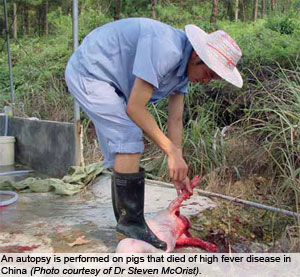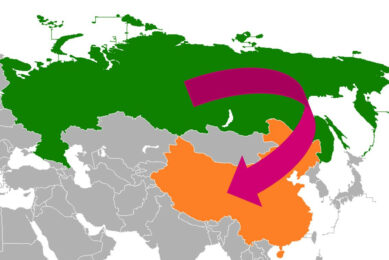Highly pathogenic PRRS in China: From outbreak to control

The heart of China was the first to record occurrence of what later turned out to be Highly Pathogenic PRRS, in the spring of 2006. At the time it was unknown what exactly the origins were of the disease – but now, some years later, causes, effects and treatments have become clearer.
By Dr Carlo Maala and Dr Marika Genzow, Boehringer Ingelheim Animal Health
The first international awareness of a new disease in China became evident on the Internet platform Promed, where a report in April 2006 stated that 161 pigs were found dead in two areas in China near the Fujiang river in Zhejiang, Jiangsu province.
Initially, the new phenomenon was referred to as ‘swine high fever disease’, or SHFD. The disease was observed and followed a pattern which started in backyard, small- and middle-size pig farms. Then, it usually spread to extensive pig farms. It caused high morbidity and mortality in pig herds, the animals having higher body temperature, rubefaction on the skin, blue ears, respiratory disorder and gastrointestinal symptoms. An infection with Porcine Respiratory and Reproductive Syndrome (PRRS) was suspected, but not yet confirmed.
The change of season did not affect its spread – and soon identical clinical situations were recognised in neighbouring provinces in the middle and south of China, including Hunan, Hubei, Zhejiang, Fujian and Anhui. After August 2006, the disease spread to Henan, Shandong, Hebei, Beijing, Tianjin and Guangdong province, after which China reported the disease to the OIE. In April of the next year, there was a new wave of outbreaks in Sichuan and Henan and the northern provinces were affected in July 2007.The unprecedented large-scale outbreak resulted in a dramatic decline of pig numbers, especially in severe epidemic areas, and the bankruptcy of large numbers of small- and middle-size pig farms, and brought great economic loss to the Chinese swine industry. This disease was the major reason for sky-rocketing prices of pig and pork in 2007 in China. Pork was sold at prices up to 75% higher, even causing inflation in other parts of the Chinese economy.At last year’s Asian Pig Veterinary Society (APVS) Congress in Tsukuba, Japan, Dr Hanchun Yang, connected to China’s College of Veterinary Medicine and the Agricultural University of Beijing, spoke about the outbreak. In his presentation ‘High virulent PRRS in China – truth or false’, he said that due to no strict control measures at the beginning and no effective measures to restrict pig trade and movement among the different areas, the outbreak was pandemic all over the country.
The disease did not stop at the borders of China. The disease spread rapidly to other countries including Vietnam, Laos, Cambodia, the Philippines and Bhutan, as can be seen in Figure 1. Even Thailand may have been infected. In total, more than 2,000,000 pigs were involved, causing great concern to the global swine industry and to public health.
Zoom
What type of viruses were at the bottom of the outbreak? Several laboratories in China have isolated the same PRRSV strain in the epidemic areas or pig farms of the outbreak, and completed the whole genomic sequencing of the viruses. Genomic analysis showed that all the PRRSVs isolated from the outbreaks of Porcine High Fever Disease belong to the North American genotype and share a unique discontinuous deletion of 30 aa in Nsp2.
To confirm that the newly isolated PRRSV was the causative agent for the virulent outbreaks in China, an experimental infection was conducted. The clinical signs of ‘high fever disease’ could be re-produced in this experimental setting, which confirmed that disease is caused primarily by a highly pathogenic PRRSV strain, however common co-infections with other agents like PCV2, Classical Swine Fever (CSF) virus and Mycoplasma hyopneumoniae are contributing to the disease in the field.The origin of the virus is still mysterious. At the APVS, Yang speculated that the highly pathogenic (HP) PRRS in China experienced a gradual variation and accumulated genome changes from Chinese domestic viruses during its emergence. To date, it remained unclear to him, however, why the virus did exhibit high pathogenicity (fatality) for pigs compared to previous strains and other North American type strains.
It is well known that PRRSV can cause immunosuppression and result in secondary bacterial infection in the affected pigs – and so did it happen with this strain. The pigs infected with the highly virulent PRRSV displayed severe secondary bacterial infection in the field. The major secondary infectious pathogens include Haemophilus parasuis, E.coli, Streptococcus Suis Serotype 2, Salmonella, Pasteurella multocida and eperythrozoon.
A closer look at HP-PRRS epidemiology
Yang also closely described clinical symptoms, including depression, anorexia, lethargy, rubefaction on the skin and in the ears. Most of the diseased pigs showed respiratory distress, including sneezing, coughing, dyspnea, increased eye secretion, conjunctivitis; constipation or diarrhoea, and neural signs were seen in some cases. In the long-term course, the diseased pigs became pale, emaciation, rough hair coats. Some affected pigs could survive and recovered gradually. Pregnant sows in different stages could be affected.At autopsy, the common lesions included e.g. dermatorrhagic, pulmonary oedema, lung consolidation, oedema of lymph nodes. |
Strategies
Several inactivated and modified live-vaccines have been applied by Chinese farmers for controlling the highly pathogenic (HP) PRRSV, with mixed results. Killed vaccines used in PHFD have shown to have little effect as mortality is still greater than 40%. Two live vaccines are licensed in China and these were considered to be more effective for PRRS, but initially, animal experimental evidence was lacking.
Using HP PRRSV JX143 strain, an isolate causing high fever disease as the causative virus, Chinese researchers from Shanghai conducted an animal trial for evaluating the vaccine Ingelvac PRRS MLV, manufactured and marketed by Boehringer Ingelheim Animal Health, against PHFD.Fifty-four, 29-day old pigs negative for PRRSV and PCV2, were randomly assigned to groups 1, 2, or 3, each containing 22, 12 and 14 pigs, respectively. Group 1 animals were vaccinated with the vaccine, group 2 was placebo vaccinated and challenged, while group 3 served as strict controls. On 28 days post-vaccination, groups 1 & 2 were challenged with the virulent virus and all pigs were monitored by daily clinical observation as well as bled at various time points. Pigs were and necropied on 21 days post-challenge. Pigs in the vaccinated group showed better performance in various ways – e.g. average clinical scores of respiratory disease were lower and shorter in the vaccinated group (Figure 2). More interestingly, all of the vaccinated pigs survived by the end of the study, while eight out of 12 mock-vaccinated pigs died. Average daily weight gain (ADG) of the vaccinated pigs (0.33 kg) was similar to the strict control (0.30 kg), the challenged negative control had a much lower ADG (0.04 kg), also see Figure 3. The data presented from this study clearly indicates that the vaccination was highly efficacious with having 100% survival and had lower ratio of clinical signs and viraemia, less severe lung lesion, fewer, lighter and shorter clinical signs, and a shorter period of high rectal temperature as compared to the non-vaccinated pigs (Figure 4).One could argue that results from experimental trials don’t translate into the field situation; however, there were several publications at the Tsukuba APVS Congress and the recent Vancouver IPVS Congress showing that vaccinated pigs survived up to 100%.
Conclusion
Currently, the epidemic of HP-PRRS is not completely controlled yet in Asia. A number of small- and middle-size pig farms still suffer of HP-PRRSV frequently, and the high mortality and morbidity are still observed in pig herds. The production performance is unstable in pig farms with the virus infection, especially in suckling and nursery pigs. Thus, HP-PRRSV will continue to exert impact on the Asian swine industry for a long time. A lot of work for the complete control of PRRS still needs to be done in Asia, particularly in the prevention of PRRSV spread among different areas. There is a sunny side to the outbreak though. The devastating impact of the disease has made crystal clear how important it is to have well-developed, high health and proper production facilities. In a country which is growing at the speed of China, new production sites are necessary which combine the strategy of ‘meeting the demand’ with ‘producing high-quality pork’. Undoubtedly, this awareness has increased tremendously in China.











